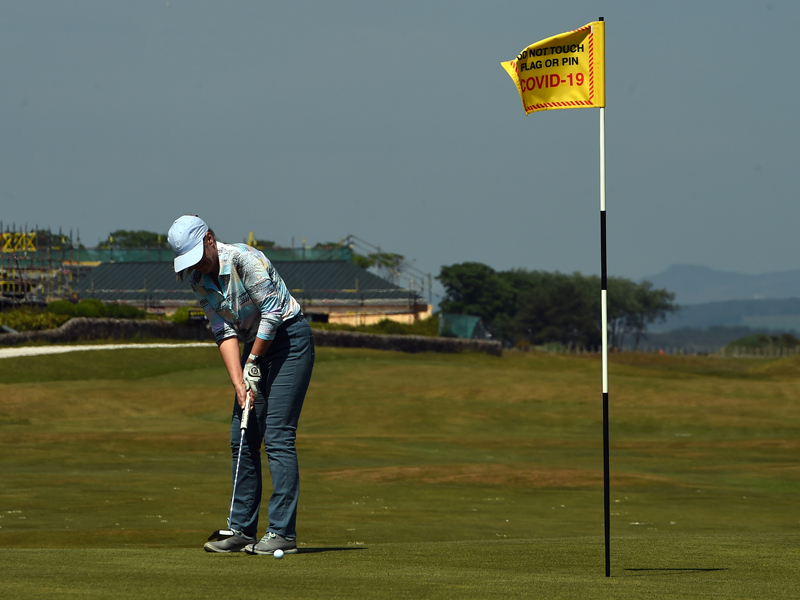Should The Flagstick Remain In For Good?
Do apparent pace of play improvements warrant a full-time change?


Fergus Bisset and Jeremy Ellwood debate whether the apparent pace of play improvement is sufficient reason to merit a full-time change in playing culture.
Should The Flagstick Remain In For Good?
Yes says Fergus Bisset
Poor pace of play is one of the biggest issues our sport faces and methods to make improvements in ways that don’t fundamentally alter the sport should be embraced.
It’s absolutely clear to me after a couple of months of post-lockdown golfing that leaving the flagstick in is significantly expediting play.
For that reason, I believe the flagstick should now remain in for good.
On each green, the need to ask for preferences, remove and replace the flag (perhaps on multiple occasions) has gone.
Subscribe to the Golf Monthly newsletter to stay up to date with all the latest tour news, equipment news, reviews, head-to-heads and buyer’s guides from our team of experienced experts.
As a result, minutes are being saved and golfers across the country are enjoying shorter rounds.
Further time is being saved as leaving the flag in more effectively facilitates “ready golf.”
People are simply putting when the opportunity is right to do so, even if a playing partner is yet to reach the green, and holes are being completed far more quickly.
It's a breath of fresh air to witness the group in front stepping onto a green and leaving it again promptly.
There’s so much less standing around waiting, wondering if it’s all worth it.
Since the new flagstick rules came into play at the start of 2019, many have decided they prefer keeping the stick in anyway, even at the highest level.
Bryson DeChambeau has recently put on a pretty good demonstration of how effective it can be.
Those who still prefer seeing an empty cup will soon get used to the new normal (many, including me, have already done so.)
I played with a friend yesterday who summed it up –
“Personally, I would prefer to putt with the flag out,” he said. “But seeing how rounds have sped up recently, I’m very happy for it to stay in!” … My thoughts exactly.
Should The Flagstick Remain In For Good?
No says Jeremy Ellwood
Much has changed as a result of the coronavirus in far more important arenas than golf, but a number of enforced changes to the game’s protocols have sparked much discussion, whether it’s about twoball golf or bunker rakes or now the flagstick here.
Last year, many of the golfing community were up in arms about the advent of putting with the flagstick in as the 2019 Rules revisions took effect; just 18 months later some are now advocating leaving the flagstick in the hole permanently following perceived pace-of-play benefits after golf’s ‘no flagstick touching’ return.
But welcome though these pace-of-play improvements may be, they’re only one part of the equation.
The new Rule was written to give golfers choice, rather than to impose a whole new putting world on them.
Yes, improved pace of play was one of the hoped-for benefits, along with less wear and tear around the hole, but the Rule change was never intended to potentially penalise those unable or unwilling to make such a mental or visual leap.
Confident, aggressive putters used to rapping the ball in firmly might have to consider a major strategy and technique rethink, as unhelpful ricochets could lead to undesirable results if forced to putt with the flagstick in.
Many people had become ‘flagstick in’ converts anyway from certain ranges pre-covid, certainly in the friendly knocks that account for most club golf, so time savings had already been reported.
And when it comes to competitions, well, most golfers accept that things will probably take a little longer anyway with people concentrating more as they try to put a score together.
So, let’s leave things as The R&A intended and allow golfers free choice over the flagstick.

Fergus is Golf Monthly's resident expert on the history of the game and has written extensively on that subject. He has also worked with Golf Monthly to produce a podcast series. Called 18 Majors: The Golf History Show it offers new and in-depth perspectives on some of the most important moments in golf's long history. You can find all the details about it here.
He is a golf obsessive and 1-handicapper. Growing up in the North East of Scotland, golf runs through his veins and his passion for the sport was bolstered during his time at St Andrews university studying history. He went on to earn a post graduate diploma from the London School of Journalism. Fergus has worked for Golf Monthly since 2004 and has written two books on the game; "Great Golf Debates" together with Jezz Ellwood of Golf Monthly and the history section of "The Ultimate Golf Book" together with Neil Tappin , also of Golf Monthly.
Fergus once shanked a ball from just over Granny Clark's Wynd on the 18th of the Old Course that struck the St Andrews Golf Club and rebounded into the Valley of Sin, from where he saved par. Who says there's no golfing god?